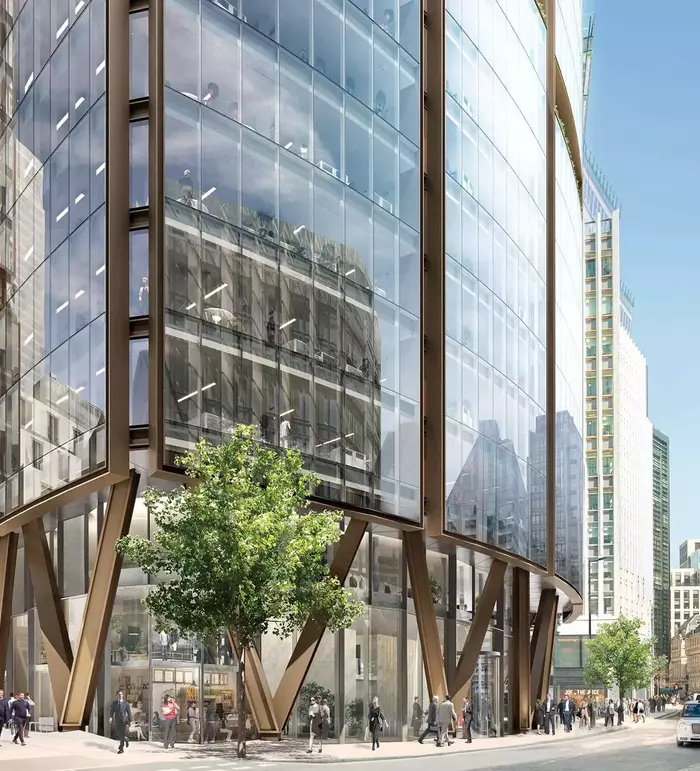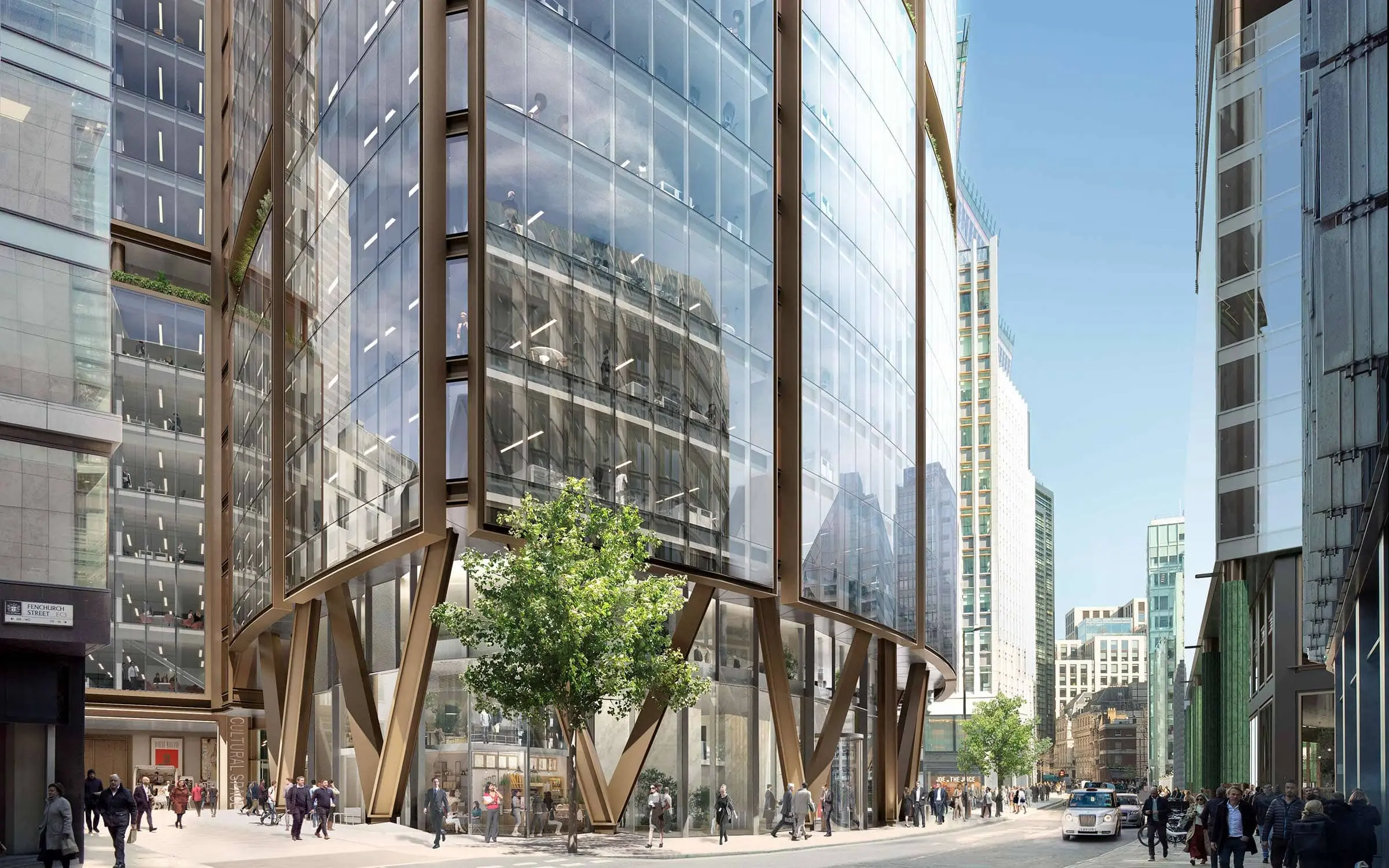The City of London is pressing ahead with a major refresh of its office stock, centred on 130 Fenchurch Street. The scheme clears a tired post-war block and replaces it with a next-generation workplace, new routes and publicly accessible space. It also lands at a moment when companies are planning moves years in advance, especially for highly sustainable, well-connected towers.
For occupiers weighing the next five to ten years, this pipeline matters. It affects when top-grade floors will be available, how the public realm will function around core locations such as Leadenhall Market, and what sustainability standards will become the new normal. If your brief includes the phrase “prime, low-carbon and flexible,” this is very much your market. For near-term options, while you plan ahead, explore our City of London office space page.
Key takeaways
- The pipeline adds high-spec City of London new office space with strong sustainability aims.
- 130 Fenchurch will deliver large, Grade A floors with new routes and public space.
- Expect demolition to start before main works, with staged milestones to 2030.
- Prime demand is shifting toward low-carbon towers in the Square Mile new office space market.
- Elizabeth line links widen talent catchments and cut journey times.
Demolition and site preparation at 130 Fenchurch Street
The existing office block at 130 Fenchurch Street, known as Fountain House, is slated for clearance to enable the redevelopment. The City of London Corporation has approved a scheme that delivers over 57,000 sq m of Grade A office space and introduces the first stage of a north-south pedestrian route connecting toward Leadenhall Market, as set out in the Corporation's planning update on the project in the planning update.
Press reports confirm the consent and highlight a faceted, jewel-like design with a programme that sequences demolition ahead of main construction, with completion targeted by the end of the decade, reflecting the complexity of the plot and public realm as reported by Construction Enquirer.
What's being cleared and when
Site clearance will remove the extant structure and podium, followed by enabling works for piling, welfare and logistics. The City's emphasis on permeability means parts of the future route can be prepared during early superstructure stages. The developer team notes demolition is scheduled for 2026, with a 2030 target for completion in sector coverage.
Construction phases for the new towers at 130 Fenchurch
Large City towers tend to follow a clear rhythm, and this scheme will be no exception. After demolition and enabling works, expect piling and foundations, core rise, steel frame, facade installation, Cat A delivery by stack and then commissioning. The inclusion of a new pedestrian route will shape hoarding layouts and site access, since parts of the ground plane are likely to arrive in phases that dovetail with core and frame progression.
The faceted massing will demand a carefully sequenced facade package once the steelwork reaches mid-rise, which is the point at which interior trades can start in earnest. That matters for occupiers keen on early occupation or phased pre-lets, because facade progression sets the pace for fit-out areas to hand over.
Programme milestones from enabling works to topping out
- Enabling works and utilities diversions following demolition and site possession.
- Piling and raft works to establish the basement and core footprints.
- Core and frame rise, enabling facade installation by zones.
- Cat A delivery proceeds in parallel by stack to support phased pre-lets.
- Testing, commissioning and certification ahead of occupation and route opening.
Sustainability features shaping the City of London's new office space
The City's recent approvals set a clear trajectory for energy, carbon and wellbeing performance. For 130 Fenchurch, official communications stress best-in-class office space and improved public access, which in practice means advanced envelope performance, electrified heat via high-efficiency heat pumps, low-carbon concrete options, heat recovery and data-driven building analytics as outlined by the City.
Sector commentary around the consent references ambitions in line with benchmarks such as BREEAM, NABERS and WELL, which underpin lower energy intensity and stronger wellbeing outcomes in BDC Magazine's coverage. If you need prime space that already delivers strong sustainability today, browse our filtered list of flexible offices.
Certifications, energy and wellbeing targets
Expect the familiar combination of high-performance glazing, smart controls, heat-pump-based systems, generous fresh-air rates and amenities that encourage movement and daylight access. These characteristics are now the baseline brief for high-end City developments, and they are increasingly non-negotiable in corporate ESG strategies.
Supply outlook in the Square Mile new office space pipeline
Project starts across London have picked up, led by larger commercial schemes. Glenigan's latest analysis reports that office starts in London were worth about £2.1 billion in the three months to August, more than double the level a year earlier, which flags a late-decade wave of completions for HQ-grade buildings according to Glenigan.
Inside the City, the policy stance is clear. The Corporation's consent for 130 Fenchurch emphasises Grade A workspace and better permeability, a pattern echoed across the pipeline and in developer statements that stress public value alongside net area in the planning announcement. For teams seeking Square Mile new office space, the 2029 to 2031 window looks particularly active for top-spec deliveries.
How demand is shifting toward prime, low-carbon stock
Flight-to-quality is still dominant. Corporate briefs centre on generous floor-to-ceiling heights, outdoor terraces, strong wellness credentials and a hospitality-grade amenity mix. If you want to see what that looks like near Fenchurch Street today, scan the current listings on our Fenchurch Street offices page.
Amenities, public space and the evolving public realm
The City is placing visible weight on the public realm and permeability. At 130 Fenchurch, the plan introduces a new pedestrian route that improves connections toward Leadenhall Market, setting a precedent for how tall buildings will be assessed on ground-level benefits as well as skyline expression in the approval.
Nearby projects show how modern towers can knit heritage and public access together, with conservation engineering paired to plazas and planted terraces. For occupiers, the setting around a building is increasingly part of the brief, since client hosting and informal collaboration often spill into the streets and pocket parks around the tower. For immediate choices with strong amenity clusters, our London office search hub is a useful starting point.
Routes, gardens and mid-level “pause points”
Expect wayfinding that draws people through the site, with permeability designed to spread footfall and support local retail. Where internal public spaces are provided, they often sit at intermediate levels with framed views, which can double as informal meeting spots and community programming spaces.
Transport links and commuter experience
Transport is the City's enduring strength. The Elizabeth line has reshaped commute times and talent catchments, improving east-west resilience and reducing reliance on single interchanges. Service details and quieter-time predictions give teams a practical way to plan core hours and staggered starts on the TfL Liverpool Street page.
From 130 Fenchurch, workers will have quick access to Bank, Monument, Cannon Street and Liverpool Street, with multiple Underground and national rail interchanges within walking distance. That redundancy is helpful for business continuity planning and a strong HR talking point for attracting talent across Greater London.
Elizabeth line plus classic City connectivity
The Elizabeth line connects the City spine via Liverpool Street and Farringdon, linking Heathrow, Paddington and Canary Wharf with predictable journey times. Combined with the Circle, District, Central and Northern lines, the City remains a uniquely connected district for knowledge-intensive work.
Completion dates and what occupiers should plan for
Based on the City's notice and subsequent reporting, demolition and enabling are expected mid-decade, with main construction running through the late 2020s and completion around 2030 as summarised by BDC Magazine. That timeline aligns with typical tall-building programmes, given facade complexity, public realm delivery and certification.
For occupiers, the planning window is now. Many large companies scout HQ-scale floors up to five years ahead, and pre-let activity tends to start once cores reach several levels above ground. If you need a near-term base that mirrors late-decade standards, one practical approach is to secure a high-spec flexible office now, while mapping a pre-let in a 2029 to 2031 delivery. You can benchmark immediate options across the City on our City listings and build a timeline with our team.
How to time a move or pre-let strategy
Start with lease events, headcount and critical systems. Allow generous lead times for landlord approvals, fit-out and commissioning, particularly if you need specialised MEP or broadcast-grade acoustic controls. If you want a first-wave occupation, engage with core-and-shell mid-rise so Cat A areas can be prioritised for your stack.
Conclusion
130 Fenchurch Street strengthens a clear City story: more Grade A space, better public routes and a rising sustainability bar. The next few years will reward teams that act early. Secure what you need now in the City, set your pre-let horizon for late-decade schemes and keep ESG, amenities and commute quality at the heart of the brief.
FAQs
Is 130 Fenchurch Street confirmed and what will it deliver?
Yes. The City of London Corporation has approved the redevelopment, confirming over 57,000 sq m of Grade A space and a new pedestrian route toward Leadenhall Market in its planning update.
When will demolition and main construction happen?
Demolition is expected in 2026, followed by core, frame and facade through the late 2020s, with completion around 2030 as reported by BDC Magazine.
Who is behind the scheme?
The project is backed by Aviva Investors with CO-RE as development manager, following unanimous planning approval by the City's Planning Applications Sub-Committee, as confirmed by CO-RE.
What sustainability standards are expected?
Sector coverage points to ambitions consistent with BREEAM, NABERS and WELL, which support credible ESG reporting for occupiers in BDC Magazine's report.
What is the wider supply picture in the Square Mile?
Glenigan notes that London office starts were worth about £2.1 billion in the three months to August, signalling a healthy pipeline into the end of the decade in its capital outlook.
















